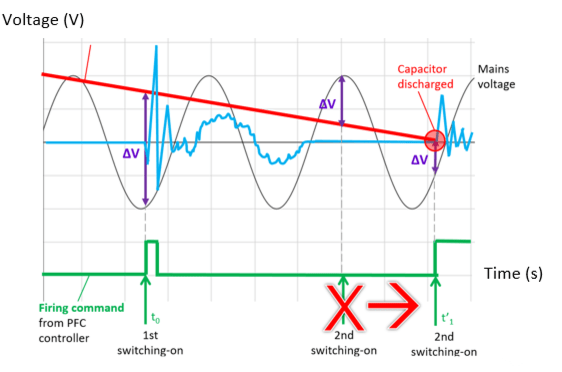If we consider a facility where considerable reactive load variations are taking place, capacitor banks connected to that installation has to follow up a dynamic operation with its steps since it has to respond to the dynamic reactive load variation very fast and provide the required KVAR to the system to maintain its power factor at desired value. That’s where the dynamic action of the power factor correction capacitor bank requires.
When the capacitor supply is disconnected, stored charge of the capacitor is discharging through its discharging resistors. Accordingly the voltage of the capacitor terminals are gradually decreasing. (Red-line in Figure 1). A standard capacitor would take around 60s to discharge and have a voltage less than 75V.
If the capacitor bank steps required switching several times per minute following a dynamic reactive power load variation, there could be a considerable voltage variation between the capacitor terminal voltage and the supply voltage as per the Figure 1. (This variation is marked as ∆V in figure 1).This voltage variation is proportional to the switching inrush current of the capacitors as per the following formula

Figure 1: Contactor Switching

In order to reduce this inrush current and preserve the life of the contactors, it is necessary to a have a minimum delay time of of 60s between two consecutive insertions of the same step. Due to this delay time, solid state switching contactors cannot be used to compensate fast variations of the PF due to rapid changing of the load conditions.
Moreover if contactors are used in such applications with frequent switching cycles, they will worn out very quickly and this can lead to safety risks for the whole system
How Thyristor switching overcome this?
Thyristor controlled switching modules follow a principle called “zero-crossing” where the switching of the thyristor module connected to the capacitor step is done precisely when the difference between the mains voltage and the residual voltage on the capacitors is equal to zero.
The following Figure 2 depicts that when the controller requires to connect the capacitor step at ![]() occasion thyristor module waits and switch on when the capacitor voltage and the supply voltage becomes equal
occasion thyristor module waits and switch on when the capacitor voltage and the supply voltage becomes equal ![]() where ∆V = 0V.
where ∆V = 0V.

Figure 2: Thyristor switching
It is evident that using thyristor modules for capacitor switching does not create transients due to inrush currents and it doesn’t required to wait the discharge time to reconnect. Accordingly for the facilities where it requires dynamic power factor correction capacitor banks, thyristor modules are the ideal solution for fast, safe and reliable operation
